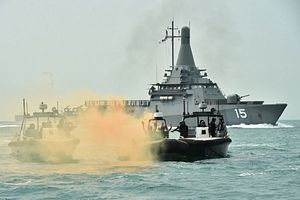Last week, Singapore staged another iteration of a complex, interagency maritime security exercise. The exercise, which was observed by top defense officials, is yet another sign of the city-state’s determination to boost its readiness amid the rising terror threat in the wider region.
As I have noted before, Singapore has long been warning about the Islamic State threat in Southeast Asia and has been taking a series of steps to both contribute to confronting the challenge in the region and further abroad as well as strengthen its response at home (See: “Singapore Warns of Islamic State Base in Southeast Asia”).
Domestically, policymakers have been undertaking measures including boosting surveillance, investing more in rehabilitation programs, raising public awareness, adjusting the way it conducts homeland defense and security operations, and using various means including drills to assess their responses (See: “Singapore Reveals New Military Facility Amid Rising Islamic State Threat”).
Indeed, with respect to exercises, just earlier this month, Singapore staged the first-ever large scale, interagency counterterrorism drills at Changi Airport as part of the tenth edition of two decade-old Exercise Northstar (See: “Singapore Holds Terror Drills in Changi Airport”).
On the maritime security front, one of the key exercises has been Exercise Highcrest, a biennial exercise that is meant to test the ability of the Singapore Maritime Crisis Center and various agencies to plan and effectively manage a whole-of-government approach to simultaneous maritime security threats.
From October 19 to 26, Singapore held the 2017 iteration of Exercise Highcrest. This year’s drills involved about 300 personnel from 14 national agencies, including the Republic of Singapore Navy, the Singapore Police Force, the Singapore Civil Defense Force, the Immigration and Checkpoints Authority, Singapore Customs, and the Maritime and Port Authority of Singapore.
According to Singapore’s defense ministry (MINDEF), Exercise Highcrest 17 tested these agencies on a range of maritime terrorism scenarios, including an infiltration from sea, and a chemical attack on board a ferry.
Several Singapore defense officials, including Senior Minister of State for Defense Mohamad Maliki bin Osman, Permanent Secretary Chan Yeng Kit, and Chief of Navy Rear-Admiral Lew Chuen Hong, also visited the exercise on October 26 to witness the capabilities of the Singapore Maritime Crisis Center (SMCC) to counter terrorist threats at sea.
The exercise saw the RSN’s Independence-class Littoral Mission Vessel and the Police Coast Guard’s PT-class Patrol Interdiction Boat and PK-class High Speed Interceptors collaborating to prevent an infiltration by terrorists on speedboats. MINDEF said that the demonstration included an update on how the SMCC can identify threats through its suite of surveillance, sense-making, and data analytics capabilities; how a report through the SGSecure App was used to corroborate the presence of a terror threat; and how the SPF’s Coastal Hardening Strike Force contributed in apprehending the perpetrators.

































